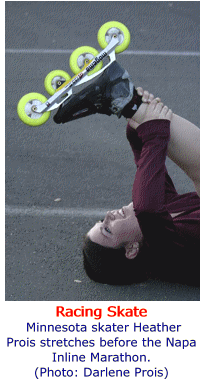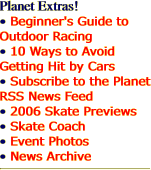 |  | |||||||||||||||||||||||||||||||||||||||
 | ||||||||||||||||||||||||||||||||||||||||
The Beginner's Guide to Outdoor Racing > Part 5 Getting More Involved in Racing
Racing skates have low-cut, hard carbon boots (like bike shoes) and longer frames with bigger wheels. Stores don't carry them. You have to order them from web sites, or from actual human beings you meet at events. Racing skates are usually sold piecemeal (boots, frames, wheels and bearings separately), although you can also buy compete setups. There are many styles and it's all very confusing, especially if you have no one to compare notes with. I suggest that unless you have money to burn, buy your first speed skates from the used section of an online skate store. Choose something reasonably current (meaning low cuff and 84mm wheels or bigger). That way you can start figuring out what you need, and if it doesn't work out, you can resell it without dropping much money. What about transitional (marathon) skates — long frames and big wheels with a tall, cushy boot? If you are serious about racing, you are better off choosing a full-fledged racing skate. What kind of socks do I wear with racing skates? Abandon your big cushy cotton tube socks. Wear thin bike socks or skate barefoot with neoprene ankle booties. I'm getting blisters! These racing skates suck! Well, all racing skates cause blisters (especially at first) because of the hard boot and close fit. One way to reduce blisters is to buy some neoprene ankle booties. With or without socks, they work like a charm. Another thing that helps is to improve your technique. Blisters are often caused by pronating and having too much weight on your toes as you stroke (especially if your foot is somewhat behind your body when you lift it off the ground, instead of out to the side where it should be). However, if you have skated on them for a few weeks and have tried the above fixes without relief, your skates may not fit right. In that case, seek professional help. Your skates may need to be remolded or maybe you just need a different pair. How do I maintain my skates? Clean your bearings after skating in the rain and rotate your wheels before they get cone-shaped. There are plenty of instructions for this floating around the Web. Ouch! What do I do about road rash? Don't sweat it — abrasions from falls are par for the course. Wash your wound really well and plaster it with Tegaderm, Activ-Flex or Advanced Healing Band-Aids or other airtight dressings. You will heal faster and prettier with these new dressings, plus you will be able to shower and won't have to worry about ooze getting on your clothing. Large sheets of Tagaderm are available in medical supply stores or on the Web. Keep a well-stocked first aid kit in your trunk. I want to skate in the Pros! How do I learn? I hate to say it, but you can't learn to speed skate from an article, book, web site, video or once-a-year weekend clinic. The only way to learn is through consistent face time with other speed skaters. Consider joining the nearest outdoor skate club or indoor speed team and plan to attend practices — even if means a long commute — as often as possible. How do I find people to skate with? The Internet, of course. For an indoor practice, try a search phrase like “speed team roller rink” plus your state. And don't just show up cold to an indoor practice — connect with the coach or call the rink ahead of time. Many clubs have special practices just for beginners. (Note: indoor requires special wheels. Check with the coach for loaners.) Find an outdoor skate club through Yahoo Groups or listings on major skating web sites. Then join their listserv to find out what's happening. If it's not clear from the web site or listserv, email the coordinator to find out where and when the local racers go to train. If you are just starting out, there will be a large pool of people with something to teach you. Pick the fastest people you can keep up with and do as they do. ... People are friendly. As long as you show some respect, they will help you figure it out. I heard that if I'm serious, the only way to train is indoors. Many people say that, but you can develop your skills in any setting, especially if you are new to the sport. Indoor practices tend to be more focused on the development of racing skills than outdoor skating, which tends to be more social. Most Pros come from indoor because it's a safe place for kids as young as 3 to learn the sport, and many high level skills and tactics can only be practiced with skaters of similar ability, which are easier to find indoors. However, plenty of Pro skaters train exclusively on the open road, and most indoor clubs hold outdoor practices regularly. I went to an indoor practice and I can't do it! How am I ever going to learn? It's tricky, and takes longer to pick up than road skating. But don't despair. You don't have to be a great indoor speed skater to enjoy racing outdoors. In fact, many people who are quite good at one are not so good at the other. You may find it necessary to work out some technical issues before getting a good workout with an indoor team. Most clubs put newbies and slower skaters in the front of the pack, which makes it very hard to learn by imitation. If this is the case and you find you're not improving on your own, ask your coach to sandwich you between two better skaters for a couple of laps. Then you can mimic the person in front of you, and the person behind you can tell you what you're doing wrong. A breakthrough may be right around the next turn. ... This may all seem like I lot to remember. But hang in there. Pretty soon you'll be rollin' with the best of them. Go to: Part 1 - Race Categories Part 2 - Drafting and Pacelines Part 3 - Race Dynamics and Interval Training Part 4 - Race Day: Fashion, Food and Packing Part 5 - Getting More Involved in Racing | Discuss Sections: Part 1 - Race Categories Part 2 - Drafting and Pacelines Part 3 - Race Dynamics and Interval Training Part 4 - Race Day: Fashion, Food and Packing Part 5 - Getting More Involved in Racing • Get in touch with Kim Perkins or sign up for coaching at her web site. Related reading: | |||||||||||||||||||||||||||||||||||||||
... Copyright © 2006 by Robert Burnson | ||||||||||||||||||||||||||||||||||||||||

